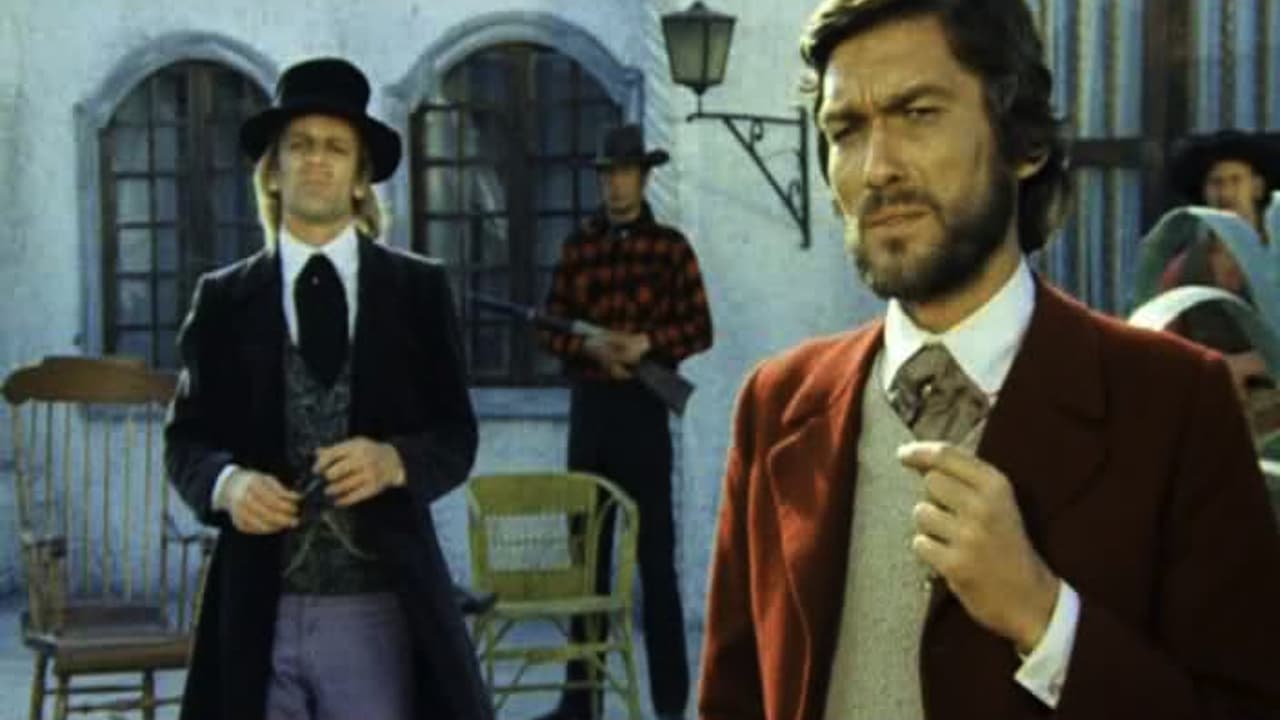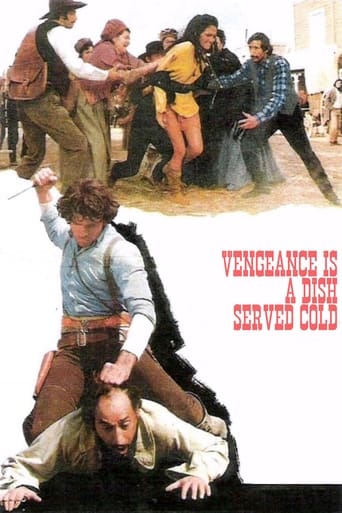

"Death's Dealer," another Western that had potential, but was wrecked by slapstick comedy. In this case the project was absolutely trashed by really dumb, unfunny slapstick humor. Actor Leonard Mann, who did a few Westerns during this period, has great screen presence, and he is good here, as a man who has been deceived into thinking a pack of Indians murdered his parents when he was a boy. It turns out that greedy, white men massacred his family, over a property dispute. Then...cue the sidekick buddy and the endless set pieces of inane stupidity, that completely sinks the production. As soon as the movie begins to get good, the momentum is quickly destroyed by more comedy. Of course humor can work..if it's well- written, and actually "funny," such as in films like "Ben & Charlie," a Western that is successful in it's comic attempts. It seems like the creators of "Death's Dealer" couldn't decide if they wanted to make a serious film, or a light comedy/action/Western. The end result is a disappointment. And it was almost painful to see the Great Klaus Kinski in such a flop, although he is barely on screen. Skip this one and seek out "Forgotten Pistolero," another film with Leonard Mann in the lead role. Now this is a truly excellent movie, with an intricate tale of revenge and family drama, as well as some impressive action sequences...and no comedy. And for Kinski fans, look no further than "The Great Silence,' which is a true masterpiece of the genre..
... View MoreLa Vendetta è un piatto che si serve freddo (1971) is one the better Italian westerns from late in the Eurowestern film cycle. It combines a naturalistic cinematographic style with an excellent score and the classic Italian western plot. Except for some ridiculous 1970s platitudes about Native American, it is intelligent scripted though the character dynamics seem unintelligible to many viewers. This is due to the fact that the ideology which informs this movie is not that of the American western or other film genres but instead the special ethos and logic of the Italian Western, of its makers, and of the culture in which they were living. This movie is actually a distillation of many early preoccupations within the genre. Many late cycle Eurowesterns are distilled versions of earlier narratives developed in the genre, with the most notable being Sonora (1969), Keoma (1976), Grand Duel (1972), or California (1977). The significance of the cinematic gestures and images is embedded in that historical ethos. Approaching it from another is to misunderstand it a senseless jumble of incoherent images.Basically, the film is a rendition of the Fistful of Dollars(1964) plot with elements borrowed from other Leone films and political westerns (such as Tepepa (1968) or Faccia a Faccia (1969)). Very generally, in this basic plot the hero is usually more skilled and dangerous than those around him. At first, he follows his own narrow interest, but he becomes involved in the wider society and ends up shot, stabbed, beaten, and sometimes literally crucified. He is then resurrected, returns to purge the society of those who are using their power and prowess to corrupt and oppress. This plot is liminal, which means that its crisis (the near-death/return) represents a point in which the hero is transformed in some significant way.Recurring tropes from Leone's movies (and Dario Argento's such as in Profundo Rosso (1975)) are flashbacks that are mystery to either to the audience or, more often, to both the hero and the audience. There is uncertainty as to what this memory means and it is returned to again and again with it's resolution being pivotal to the plot. This movie is structured around a memory as well, but in a slightly different way that makes it somewhat unique. The initial scene in the film, ending with the family's massacre, comprises the memory whose changing meaning to the hero provides the narrative drive to the movie. These scenes are shot as though seen at a distance, sometimes through windows or frame din other ways. As such, they are similar to a flashback sequence.The basic liminal plot together with the pivotal memory of Jeremiah's family provides the scaffolding for the political western plot. This is a West in which the powerful use the newspapers to manipulate the public with fear and racism. Jeremiah, who has become sociopath scalp-hunter, believes that his family was murdered by Native Americans. He is an outcast who barely utters a word through the first half of the movie. The near-death is accompanied by clues that his understanding of what happened was false and the second half of the film is about his accumulation of evidence that his family was murdered so the rancher Perkins would have an excuse to seize his family's land. The truth revealed, he can redirect his action in a manner that does not support Perkins but destroys him. This action is reproduced for the community and they do the same.This widening of awareness beyond the bounds of Jeremiah's own experience to the wider social manipulations of power and perception are what this strange little Eurowestern is about. The movie lacks psychological realism, instead opting for a leftist view of the dynamics of society and politics. Of course, this is not an art-film not is it Salvatore Guliano (1962) or La Battaglia di Algeri (1966). However, even Pasolini played a revolutionary priest in Requiescant (1967) and Franco Solinas wrote a number of Italian Westerns. These movies were intended for export throughout the 3rd world and the filmmakers were sincere about their politics. In a sense, this modest western may have been portraying on the screen what it was trying to reproduce in the audience the transformation of people's political consciousness. I don't know if Pasquale Squitieri had the same intention with this film or whether he was simply following the conventions of the genre, but even if he was just following the formula he understood it well enough to execute a decent and entertaining spaghetti western.Leonard Mann plays the same wounded, haunted persona that he did in Il Pistolero dell'Ave Maria (1969) and Ciakmull - L'uomo della vendetta (1970). Perkins (Ivan Rassimov) is a sadistic semi-feudal land-baron in classic Italian western fashion, dragging Chinese slaves to death behind his carriage in street. Klaus Kinski is enjoyable as the scheming newspaper editor Prescott.
... View More"La Vendetta È Un Piatto Che Si Serve Freddo" aka "Three Amens For Satan" is a rather tough Spaghetti Western, that certainly has its qualities, but lacks in many departments. On the one hand the movie could maybe have been a lot better with a higher budget, on the other hand there are a lot of excellent low-budget Spaghetti Westerns, way better than this. After witnessing the brutal murder of his entire family by Native Americans as a child, Jeremiah Bridger becomes a merciless Indian-killer and scalp hunter. After saving the life of a beautiful Native American girl named Tune, however, the lone and silent gunman slowly reconsiders his hatred. He starts to doubt his former persuasion, that it was really Indians, who killed his family, and soon has to find out that a greedy and unscrupulous landowner usually blames Native Americans for his own crimes."Three Amens For Satan" is not really a bad movie, but it's not really good either. As a big fan of Spaghetti Westerns I personally kinda liked it, although it's definitely one of the worse movies of the genre. The acting differs throughout the movie, Kinski, who plays a villainous and racist journalist, is great as always, though his part is quite small. I also found Leonard Mann to be quite good as the silent and lonely avenger. Some of the characters in this film, however, are a little annoying. The movie is not at all one of the humorous Spaghetti Westerns (no dark humor either), the character of Doc, Jeremiah's savior and buddy, who was only added to make the movie a little 'funnier', is very exaggerated, and therefore a bit annoying. Furthermore, Tune, the Indian girl, keeps talking in very stereotypical Indian wisdoms, not to mention she talks about herself in the third person throughout the whole movie."Three Amens For Satan" is certainly not a very good movie, but, apart from its several weaknesses, and the doubtable part of the plot, in which a racist Indian-killer suddenly changes entirely, and becomes kind of a hero and Indian-savior, the movie is certainly enjoyable.
... View MoreThis is a very cheap and rough looking movie, even for a Euro-Western. What makes it worth catching is that it doesn't follow the usual plot of most Spaghetti Westerns, i.e. it doesn't feature the American Civil War or the Mexican Revolution as it's backdrop.Jim(called Jeremiah in the version I saw) is the only survivor of an attack by Native Americans on his homestead. His entire family are killed, and he grows up to be a hate-filled Indian killer. This changes when he saves an Indian girl from a humiliating 'tar-and-feathering' in the local town. We later find out that it was evil property developers who organised the raid on his homestead and made it look like Indians did it. Jim/Jeremiah takes his revenge.This has an excellent sub-Morricone guitar driven score, but is ultimately let down by it's cheap look.And a word of caution; avoid the DVD version that's around at the moment. It claims to be widescreen but is horribly cropped and renders certain scenes nonsensical. 4/10.
... View More